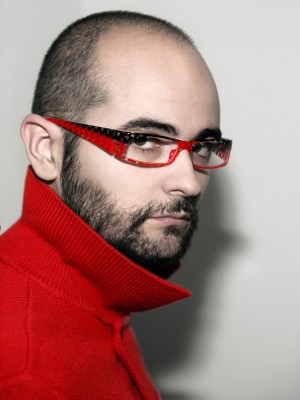The Beauty Within: Interview with Photographer Paco Peregrín
The art of photography can be an expression of a myriad of natural reflections from beautiful landscapes that have stood throughout the ages, capturing their untimely changes, to the encapsulation of hidden personalities of everyday people that often go unnoticed. But while some photographers strive to captivate the truth of what stands before their lens, others hope to portray an alternate view; a view that though premeditated and restructured, reveals the astuteness and hidden agenda of today’s society.
Advancing down this path, renowned Spanish fashion and beauty photographer Paco Peregrín has been interlacing futuristic, contemporary, and classic scenes in his astoundingly theatrical and vibrant photographs. Displays of women dressed in extravagant clothing — reminiscent of what one might find in a Tim Burton movie or a masked ball in Venice — and copious amounts of bright makeup grace the walls of various fine galleries and museums. Pushing past society’s constrictive rules, Peregrín brings an underlying sense of mystery to his work that leaves the viewer questioning the world around them. It is these illusory images that have brought him fame and prestige in the fashion and advertisement world, amongst which are some of the most highly acclaimed publications ranging from Vogue to Elle.
His recent creation, a series entitled Beautiful Monster has captivated the minds and eyes of viewers on an international level with its bare look into the beauty of human beings – giving the implication that a light of splendor radiates in each and every one of us behind the everyday mask that is worn to keep our inhibitions at bay.
In an exclusive interview for GALO, Peregrín shares his view on how Spanish culture molded his art, why he feels more like a creator of images than an artist, and reveals where we might encounter Beautiful Monster next.
GALO: How did your interest in photography blossom?
Paco Peregrín: I have always been in contact with the world of photography, but I never expected to make a living from photographing models. From a young age, I was already using the camera in an intuitive way, without technical resources, but with creativity and enthusiasm. I shot the performances of my own plays or fashion shows and I always traveled with my camera. I loved photographing things seemingly uninteresting and giving them importance through my point of view, playing with the composition, etc. It was later when I studied Fine Arts that I found my expression in that medium.
GALO: Do you remember what your first photograph was of?
PP: I guess my first photos were published to illustrate some of the fashion shows or plays in which I participated.
GALO: You were born and often work in Spain. Do you feel that your heritage helped in defining your path as a photographer?
PP: Yes, I do. Spanish culture is rich and varied. My work is strongly influenced by the Andalusian culture and the color of the Venetian Baroque and Flemish painting. Seville, the town where I grew up, has an intense theatrical and baroque character that has definitely influenced my style, just as my career as a graphic designer or other factors have shaped my point of view.
GALO: American photographer Richard Avedon once said that, “If a day goes by without my doing something related to photography, it’s as though I’ve neglected something essential to my existence, as though I had forgotten to wake up.” Do you yourself feel this way?
PP: I can’t separate the photography of my life. I identify myself with Avedon, but I consider myself more a creator of images than a photographer or an artist. It is true that I am so obsessed with my work; I can’t even live without creating pictures.
GALO: What fascinates you most about fashion and beauty photography? Why did you choose this genre of photography instead of another?
PP: I love the artistic freedom that exists in that field. Nowadays fashion and beauty photography is the most creative type of photography in the commercial market. Also, I want to portray the people but not in a realist way, I prefer to recreate reality.
GALO: Your work has been featured in an array of mediums: magazines, ads, and galleries. Is there one type of form you value more than others?
PP: All the mediums are interesting. I like to exhibit my work in galleries and museums because it allows me to use other media and formats (I can interact with the space and the viewer), but definitely, publishing a photo in a high end magazine makes your work more visible.
GALO: You have been credited as one of the most exciting photographers working in art, fashion, and beauty photography today by various magazines and newspapers. Do you find that such a title makes it harder for you to create something new because of the prestige and a certain level of expectancy that comes along with it?
PP: I always try to get a creative and quality image out of consideration for my employees and clients. But I don’t forget to have fun with each project and learn. I face each work with enthusiasm and as a challenge.
GALO: Though your exhibit at the Vered Gallery of Contemporary and Modern Art in the Hamptons has come to a close, your Beautiful Monsters exhibit in Paris is still being left to admire by thousands of viewers. How did the idea for this showcase come about?
PP: In all the cases, a gallery owner or curator has contacted me asking for an exhibition. My agent in Paris proposed to me to do a solo exhibition in Visionairs Gallery in 2012 to show my Beautiful Monsters series there. Currently, I have work exhibited in the Museum Cristobal Balenciaga, and I am going to participate in a lot of worldwide projects and exhibitions during this year.
(Article continued on next page)

